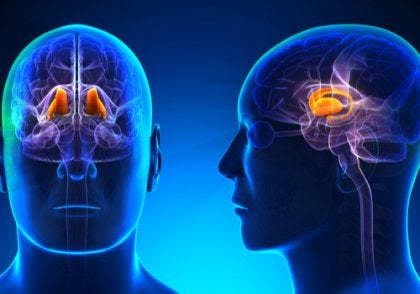How Does the Body Perceive Pain and Temperature?

Have you ever wondered why you’re capable of feeling pain? Or how you can tell when things are hot or cold? How do humans acquire this skill that’s so important to our survival? In this article, we’ll talk about the somatosensory system, which is not only responsible for enabling us to feel pain and temperature, but also proprioception, which is the body’s awareness of position, posture, movement, etc.
The somatosensory system is one of the largest systems in the body. It processes sensory information (i.e. pain and temperature) from the some (body) and the skin. Its receptors are distributed throughout the body. There are two types of somatosensory systems:
- Cutaneous somatosensory system. Receptors found in the skin make up this system. It’s a peripheral system. It has kinesthetic receptors that take in information related to body position and movement. The receptors are located near the joints and tendons.
- Organic somatosensory system. This system has receptors in the bones, muscles, and gut. It’s an internal system.

The cutaneous somatosensory system: The key to understanding perception
If you want to understand how humans perceive pain and temperature, you have to understand how the cutaneous sensory receptors work. The most sensitive sensory receptors are located on the skin and are capable of generating pain sensations.
The skin is the biggest organ in the body. Consequently, it’s also the biggest sensory receptor. There are many sensory receptors grouped together in different ways all over the body. They determine sensitivity to stimuli and any of the four sensations that you perceive through the skin: pressure, vibration (touch), pain, and temperature.
Is body hair relevant?
There’s a difference between skin with hair and skin without hair. Most of the skin on your body is covered in hair. The parts of your skin that don’t have hair actually contain many more receptors, which makes it more sensitive.
The most sensitive sensory organs are the lips, the external genitals, and the fingertips. Those parts of your body have the highest density of sensory receptors.
Although no definitive studies prove this to be true, scientists believe that skin with hair is more sensitive to vibration and touch because both make hair move.
What kind of sensory receptors are in the skin?
Cutaneous receptors are divided into two categories: free nerve endings and encapsulated nerve endings.
Free nerve endings (FNEs) are nerve fibers that end at the skin. They’re probably the simplest sensory receptors. They’re found all over the skin and are the most sensitive to pain perception. While they can also perceive other sensations, their specialty is pain perception.
The transduction mechanism of FNEs happens when a specific part of the FNEs stretches, which allows the sodium channels to open. That leads to membrane depolarization, which creates an action potential. Contraction can trigger transduction in cold temperatures and dilation in hot temperatures.
Encapsulated receptors
Encapsulated receptors are a kind of cutaneous sensory receptor. Their name is self-explanatory; they’re called encapsulated receptors because they’re covered by a capsule. Some scientists divide them into four types, others into five. They classify the receptors in the following way:
Pacinian corpuscles: Sensitive to pressure and touch
These receptors are mostly found in hairless skin, though there are also some in skin with hair. They’re densely grouped in the lips, the mammary glands, and the external genitals. Pacinian corpuscles are especially sensitive to pressure, vibration, and less sensitive to pain and temperature.
Ruffini corpuscles
These are small encapsulated receptors. Their nerve endings are similar to FNEs except that connective tissue surrounds them. They’re in the skin with hair and they respond to low-frequency vibration.
Meissner corpuscles
These receptors are designed to perceive a gentle touch. They’re found in hairless skin, specifically located in the dermal papillae.
Krause end bulbs
Krause end bulbs are exclusively found in the intersection of the mucous membrane and dry skin. Their fibers aren’t myelinated and they’re extremely sensitive to pressure. They have the lowest pressure threshold in the entire body.
Merkel’s disks
Merkel’s disks are also located in the dermal papillae. They’re slow-adapting receptors and only respond to a continued change in stimulus, such as temperature change.
Pain perception
Your body has an adaptive alert system that allows for pain and temperature perception. It helps you avoid things that might cause you harm, although emotional, psychological, and social factors also influence pain sensations. Things such as drugs, placebos, and hypnosis can also affect pain perception.
Consequently, pain is a very subjective emotion. That suggests that there must be neuronal mechanisms that modify or interfere with pain transmission and it doesn’t depend solely on cutaneous sensory receptors.
There are two types of pain:
- Avoidable pain. The best response is to withdraw from the source of the pain.
- Unavoidable pain exists on a peripheral and central level. As its name indicates, it’s the kind of pain you can’t withdraw from.
In the case of unavoidable pain, scientists observe that there’s molecular information that relates to the pain. When you feel pain, the damaged cells release histamine and prostaglandin. Histamine causes the cell’s pain threshold to fall. Prostaglandin makes the damaged cells more sensitive to histamine, which affects the pain threshold even more. This kind of pain involves damaged tissue. There are drugs that block the histamine (antihistamines) and prostaglandin (acetylsalicylic acid, also known as aspirin).
Can you block pain?
Studies point to the thalamus when looking at centralized pain. Although pain is adaptive, it can affect behavior if it’s very intense. This can be counterproductive, and some people wonder if it’s possible to entirely avoid pain. Can you somehow block the thalamus?
We usually call pain suppression analgesia. Emotional and physiological factors influence the process. However, some stroke victims notice that their injury or the blockage of the ventral posterior nucleus of the thalamus tends to coincide with the loss of cutaneous sensation. In other words, they lose superficial sensations such as touch and pain.
Similarly, injuries to the intralaminar nuclei block deep pain but don’t affect cutaneous sensation. Dorsomedial nuclei relate to the limbic system and tend to interfere with the emotional components of pain.

Temperature perception
Temperature perception is relative because humans don’t have sensory receptors that provide absolute information about temperature. You’re only able to perceive sudden changes in temperature. For example, if you move your hand from very cold water to very hot water.
There are two types of receptors, one for cold and the other type for heat. They’re heterogeneously distributed all over the skin. Cold receptors are closer to the epidermis, while heat receptors are located in a deeper zone. They’re the same kind of receptors; the difference is their location.
The deformation of the membrane or the receptor cone due to dilation or contraction of the skin is what produces transduction. That deformation opens the membrane and the sodium channels. If the receptors are too close together, you’ll feel the heat more intensely. The nuclei in the thalamus that make it difficult to perceive cold or heat are the intralaminar nuclei and the ventricular nuclei.
It’s interesting, then, that pain perception and temperature reception are due to small receptors in the skin and the participation of the thalamus.
In conclusion, all of these functions seem to have developed to ensure human survival.
All cited sources were thoroughly reviewed by our team to ensure their quality, reliability, currency, and validity. The bibliography of this article was considered reliable and of academic or scientific accuracy.
- Dickenson AH. Pharmacology of pain transmission and control. En: Gebhart GF, Hammond DL, Jensen T (eds). Proceedings of the 8th World Congress on Pain, Progress in Pain Research and Management, IASP Press, Seattle, 1996: 113-121.
- Villanueva L, Nathan PW. Multiple pain pathways. En: Devor M, Rowbotham MC, Wiesenfeld-Hallin Z (eds). Progress in Pain Research and Management Vol 16, 2000; IASP Press, Seattle, 371-386.
This text is provided for informational purposes only and does not replace consultation with a professional. If in doubt, consult your specialist.








